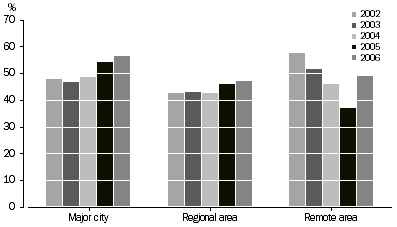NOTES
ABOUT THIS PUBLICATION
This publication presents information about the labour force characteristics of Aboriginal and Torres Strait Islander Australians. Information on labour force characteristics is presented by sex, age, state or territory, and remoteness.
The statistics in this publication were compiled from the monthly Labour Force Survey, conducted throughout Australia by the Australian Bureau of Statistics (ABS). Monthly data have been pooled to produce annual estimates.
The ABS considers the estimates in this publication experimental due to the experimental nature of the Indigenous population projections used in producing the estimates and the small sample of Indigenous people in the LFS. The estimates have been released to give users an opportunity to assess their usefulness.
Due to a change in methodology, estimates from the 1994-2000 release under this catalogue number - Occasional Paper: Labour Force Characteristics of Aboriginal and Torres Strait Islander Australians, Experimental Estimates from the Labour force Survey (cat. no. 6287.0), are not strictly comparable with the estimates for 2002-2006 in this publication.
Indigenous estimates from the Labour Force Survey have methodological and definitional differences from other sources such as the five-yearly Census of Population and Housing, the 2001 National Health Survey (Indigenous) (NHS(I)), the 2002 National Aboriginal and Torres Strait Islander Social Survey (NATSISS), and the 2004-05 National Aboriginal and Torres Strait Islander Health Survey (NATSIHS). The differences in the methodologies used affect the comparability of the data.
ROUNDING
As estimates have been rounded, discrepancies may occur between sums of the component items and totals.
INQUIRIES
For further information about these and related statistics, contact the National Information and Referral Service on 1300 135 070 or Rebecca Cash on Canberra (02) 6252 5390.
SUMMARY OF FINDINGS
PARTICIPATION
In 2006, an estimated 186,900 Indigenous people were in the labour force (i.e. either employed or unemployed). This represents a labour force participation rate for all Indigenous people aged 15 years and over of 59%.
Of the Indigenous people in the labour force, more lived in Regional areas (78,000 people) than in Major Cities (62,700) or Remote areas (46,200). Major Cities had the highest participation rate at 64% in 2006.
Males accounted for 55% of the Indigenous labour force in 2006. The labour force participation rate for Indigenous males (66%) was considerably higher than for Indigenous females (52%). After a steady decline in the participation rate of Indigenous males and females in Remote areas from 2002 to 2005, the participation rate increased for both in 2006, particularly for females (40% to 45%).
The participation rate for Indigenous people aged 15-64 years (61%) was only slightly higher than the rate for all Indigenous people aged 15 years and over (59%). Indigenous people aged 65 years and over accounted for 4.3% of the total Indigenous population aged 15 years and over in 2006. For more information see Appendix 2 Comparisons with non-Indigenous estimates.
Between 2002 and 2004, the Indigenous population not in the labour force increased from 117,600 to137,700, however it has since fallen to 131,200 in 2006. In 2006, more Indigenous people not in the labour force lived in Regional areas (56,200) than in Remote areas (40,500) and Major Cities (34,500). Females accounted for 60% of the total Indigenous population not in the labour force.
EMPLOYMENT
In 2006, there were an estimated 160,300 Indigenous people aged 15 years and over in employment. This represented half of the Indigenous population aged 15 years and over. After declining to a low in 2004 (45%), the employment to population ratio for Indigenous Australians has increased to 50% in 2006. The employment to population ratio for Indigenous males (57%) continued to rise in 2006 after falling to 52% in 2004. The employment to population ratio for Indigenous females has increased to 44% in 2006 after remaining relatively stable between 2002 and 2005.
In 2006, there were an estimated 54,800 Indigenous people employed in Major Cities, 63,200 employed in Regional areas and 42,200 employed in Remote areas. The employment to population ratio was 56% in Major Cities, 47% in Regional areas and 49% in Remote areas. The employment to population ratio of Indigenous females in Remote areas decreased 17 percentage points between 2002 and 2005, however it increased by 5 percentage points from 2005 to 2006. Indigenous males in Remote areas also experienced a considerable increase in 2006 (6 percentage points) after a decline from 2002 to 2005. Indigenous people participating in the CDEP scheme, who are classified by the ABS as employed, are likely to form a significant proportion of Indigenous employment in remote areas (see National Aboriginal and Torres Strait Islander Social Survey (cat. no. 4714.0)).
Employment to population ratio of Indigenous persons aged 15 years and over

UNEMPLOYMENT
In 2006, the unemployment rate for the Indigenous population was 14%. The unemployment rate for Indigenous people was 13% in Major Cities, 19% in Regional areas, and 9% in Remote areas. However, estimates of unemployment for Remote areas should be used with great care as they are subject to high sampling errors. In addition, Remote areas are regions which generally have an underdeveloped labour market and this is reflected in the low number of Indigenous people actively looking for work and therefore not in the labour force.
 Print Page
Print Page
 Print All
Print All